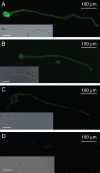The cell wall pectic polymer rhamnogalacturonan-II is required for proper pollen tube elongation: implications of a putative sialyltransferase-like protein
- PMID: 24825296
- PMCID: PMC4195553
- DOI: 10.1093/aob/mcu093
The cell wall pectic polymer rhamnogalacturonan-II is required for proper pollen tube elongation: implications of a putative sialyltransferase-like protein
Abstract
Background and aims: Rhamnogalacturonan-II (RG-II) is one of the pectin motifs found in the cell wall of all land plants. It contains sugars such as 2-keto-3-deoxy-d-lyxo-heptulosaric acid (Dha) and 2-keto-3-deoxy-d-manno-octulosonic acid (Kdo), and within the wall RG-II is mostly found as a dimer via a borate diester cross-link. To date, little is known regarding the biosynthesis of this motif. Here, after a brief review of our current knowledge on RG-II structure, biosynthesis and function in plants, this study explores the implications of the presence of a Golgi-localized sialyltransferase-like 2 (SIA2) protein that is possibly involved in the transfer of Dha or Kdo in the RG-II of Arabidopsis thaliana pollen tubes, a fast-growing cell type used as a model for the study of cell elongation.
Methods: Two heterozygous mutant lines of arabidopsis (sia2-1+/- and qrt1 × sia2-2+/-) were investigated. sia2-2+/- was in a quartet1 background and the inserted T-DNA contained the reporter gene β-glucuronidase (GUS) under the pollen-specific promoter LAT52. Pollen germination and pollen tube phenotype and growth were analysed both in vitro and in vivo by microscopy.
Key results: Self-pollination of heterozygous lines produced no homozygous plants in the progeny, which may suggest that the mutation could be lethal. Heterozygous mutants displayed a much lower germination rate overall and exhibited a substantial delay in germination (20 h of delay to reach 30 % of pollen grain germination compared with the wild type). In both lines, mutant pollen grains that were able to produce a tube had tubes that were either bursting, abnormal (swollen or dichotomous branching tip) or much shorter compared with wild-type pollen tubes. In vivo, mutant pollen tubes were restricted to the style, whereas the wild-type pollen tubes were detected at the base of the ovary.
Conclusions: This study highlights that the mutation in arabidopsis SIA2 encoding a sialyltransferase-like protein that may transfer Dha or Kdo on the RG-II motif has a dramatic effect on the stability of the pollen tube cell wall.
Keywords: Arabidopsis thaliana; Dha; Kdo; RG-II; Rhamnogalacturonan-II; pectin motif; plant cell wall; pollen tube; sialyltransferase-like protein.
© The Author 2014. Published by Oxford University Press on behalf of the Annals of Botany Company. All rights reserved. For Permissions, please email: journals.permissions@oup.com.
Figures





Similar articles
-
The synthesis of the rhamnogalacturonan II component 3-deoxy-D-manno-2-octulosonic acid (Kdo) is required for pollen tube growth and elongation.J Exp Bot. 2008;59(10):2639-47. doi: 10.1093/jxb/ern118. Epub 2008 May 23. J Exp Bot. 2008. PMID: 18503041 Free PMC article.
-
A DUF-246 family glycosyltransferase-like gene affects male fertility and the biosynthesis of pectic arabinogalactans.BMC Plant Biol. 2016 Apr 18;16:90. doi: 10.1186/s12870-016-0780-x. BMC Plant Biol. 2016. PMID: 27091363 Free PMC article.
-
Characterization of Arabidopsis CTP:3-deoxy-D-manno-2-octulosonate cytidylyltransferase (CMP-KDO synthetase), the enzyme that activates KDO during rhamnogalacturonan II biosynthesis.Plant Cell Physiol. 2011 Oct;52(10):1832-43. doi: 10.1093/pcp/pcr120. Epub 2011 Sep 4. Plant Cell Physiol. 2011. PMID: 21893514
-
How many receptor-like kinases are required to operate a pollen tube.Curr Opin Plant Biol. 2018 Feb;41:73-82. doi: 10.1016/j.pbi.2017.09.008. Epub 2017 Oct 6. Curr Opin Plant Biol. 2018. PMID: 28992536 Review.
-
Strength in numbers: An isoform variety of homogalacturonan modifying enzymes may contribute to pollen tube fitness.Plant Physiol. 2023 Dec 30;194(1):67-80. doi: 10.1093/plphys/kiad544. Plant Physiol. 2023. PMID: 37819032 Review.
Cited by
-
Comparative "Golgi" Proteome Study of Lolium multiflorum and Populus trichocarpa.Proteomes. 2016 Jul 20;4(3):23. doi: 10.3390/proteomes4030023. Proteomes. 2016. PMID: 28248233 Free PMC article.
-
Addition of Phenylboronic Acid to Malus domestica Pollen Tubes Alters Calcium Dynamics, Disrupts Actin Filaments and Affects Cell Wall Architecture.PLoS One. 2016 Feb 17;11(2):e0149232. doi: 10.1371/journal.pone.0149232. eCollection 2016. PLoS One. 2016. PMID: 26886907 Free PMC article.
-
Altered lignification in mur1-1 a mutant deficient in GDP-L-fucose synthesis with reduced RG-II cross linking.PLoS One. 2017 Sep 29;12(9):e0184820. doi: 10.1371/journal.pone.0184820. eCollection 2017. PLoS One. 2017. PMID: 28961242 Free PMC article.
-
Evolution of protein N-glycosylation process in Golgi apparatus which shapes diversity of protein N-glycan structures in plants, animals and fungi.Sci Rep. 2017 Jan 11;7:40301. doi: 10.1038/srep40301. Sci Rep. 2017. PMID: 28074929 Free PMC article.
-
Evolution of Cell Wall Polymers in Tip-Growing Land Plant Gametophytes: Composition, Distribution, Functional Aspects and Their Remodeling.Front Plant Sci. 2019 Apr 18;10:441. doi: 10.3389/fpls.2019.00441. eCollection 2019. Front Plant Sci. 2019. PMID: 31057570 Free PMC article. Review.
References
-
- Abramoff MD, Magalhães PJ, Ram SJ. Image processing with ImageJ. Biophotonics International. 2004;11:36–42.
-
- Audry M, Jeanneau C, Imberty A, Harduin-Lepers A, Delannoy P, Breton C. Current trends in the structure–activity relationships of sialyltransferases. Glycobiology. 2011;21:716–726. - PubMed
-
- Bakker H, Routier F, Ashikov A, Neumann D, Bosch D, Gerardy-Schahn R. A CMP-sialic acid transporter cloned from Arabidopsis thaliana. Carbohydrate Research. 2008;343:2148–2152. - PubMed
-
- Belunis CJ, Clementz T, Carty SM, Raetz CRH. Inhibition of lipopolysaccharide biosynthesis and cell growth following inactivation of the kdtA gene in Escherichia coli. Journal of Biological Chemistry. 1995;270:27646–27652. - PubMed
Publication types
MeSH terms
Substances
LinkOut - more resources
Full Text Sources
Other Literature Sources
Molecular Biology Databases

